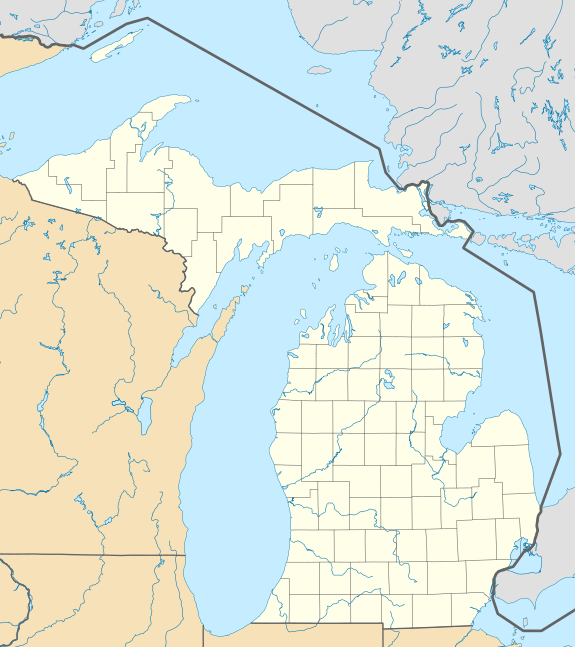Summer Island Site
|
Summer Island Site | |
  | |
| Location | Northwest side of Summer Island, Michigan[1] |
|---|---|
| Coordinates | 45°34′0″N 86°38′0″W / 45.56667°N 86.63333°WCoordinates: 45°34′0″N 86°38′0″W / 45.56667°N 86.63333°W |
| Area | 3 acres (1.2 ha) |
| NRHP Reference # | 71000388[2] |
| Added to NRHP | September 3, 1971 |
The Summer Island Site, designated 20DE4, is an archaeological site located on the northwest side[3] of Summer Island, Michigan. It was once used as a village or hunting camp. It was listed on the National Register of Historic Places in 1971.[2]
Site Description
The site lies in a sandy meadow about 20 feet above Summer Harbor on the northwest side of the island,[3] and about "125 feet inland from the best canoe landing area in the entire bay."[4] At the time it was first excavated, cultural material was evident on the surface of the site.
Archaeological history
The location of the Summer Island site was known to archaeologists at least as early as 1931, when Wilbert B. Hinsdale included it in his Archaeological atlas of Michigan.[5] The site was first excavated by George I. Quimby in 1959.[6] Quimby was able to collect material from the surface, and dug some test pits, finding pot sherds and animal bones. David S. Brose continued excavating the site in 1967.[3]
Cultural history
The site was most likely utilized by a number of different cultures.[4] The earliest occupiers were likely Middle Woodland period peoples.[4] Based on distinctive pottery associated with different residences, it is likely these people had patrilocal residences.[7] A later part of the Summer Island site included hearths, a storage pit, and waste pits, and has been ascribed Upper Mississippian culture[6] and Late Woodland period peoples.[4] The inhabitants of the site likely occupied it in the late summer, and ate a variety of game, including mammals (moose and beaver),[4] fish, birds, reptiles, and amphibians.[6] The final occupiers had early French trade goods, indicating they likely used the site around 1620; they used the site as a late summer hunting camp.[7]
A small fishing village of European settlers, believed to be associated with the fishing fleet from St. Martin Island, was established just north of the prehistoric archeological site in the 1800s.[8] The village was occupied by fishermen through at least the end of the 19th century, and then by loggers from Fayette in the early 20th century.[8]
References
- ↑ The NRIS database gives the site location as "address restricted." However, Brose describes the location as "about 20 feet above the level of Summer Harbor on the Northwest side of [Summer Island]." The given geo-coordinates are approximate.
- 1 2 National Park Service (2010-07-09). "National Register Information System". National Register of Historic Places. National Park Service.
- 1 2 3 David S. Brose (1970), "Summer Island III: An Early Historic Site in the Upper Great Lakes", Historical Archaeology, 4: 3–33, JSTOR 25615134
- 1 2 3 4 5 Lewis R. Binford; George I. Quimby (1963), "Indian Sites and Chipped Stone Materials in the Northern Lake Michigan Area", Fieldiana Anthropology, 36: 277–307
- ↑ Wilbert B. Hinsdale (1931), Archaeological atlas of Michigan, University of Michigan, p. 19
- 1 2 3 Dawn Bringelson; Jay T. Sturdevant (2007), An Archeological Overview and Assessment of Indiana Dunes National Lakeshore, Indiana (PDF), NATIONAL PARK SERVICE Midwest Archeological Center, p. 49
- 1 2 William C. Sturtevant (1978), Handbook of North American Indians, Volume 2, Government Printing Office, pp. 50, 578
- 1 2 "Summer Island Collection". Wayne State University. Retrieved April 5, 2012.
Further reading
- David S. Brose (1970), The Archaeology of Summer Island: Changing Settlement Systems in Northern Lake Michigan (Anthropological Papers No. 41), Museum of Anthropology, University of Michigan
- David S. Brose (1970), The Summer Island Site: A Study of Prehistoric Cultural Ecology and Social Organization in the Northern Lake Michigan Area, Case Western Reserve University
- David S. Brose (1970), "Summer Island III: An Early Historic Site in the Upper Great Lakes", Historical Archaeology, 4: 3–33
- Lewis R. Binford; George I. Quimby (1963), "Indian Sites and Chipped Stone Materials in the Northern Lake Michigan Area", Fieldiana Anthropology, 36: 277–307